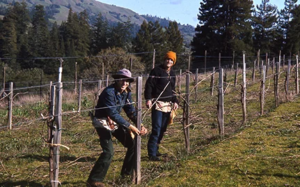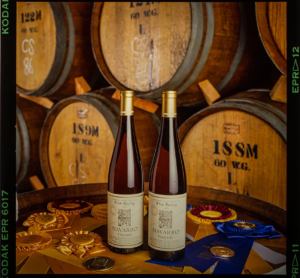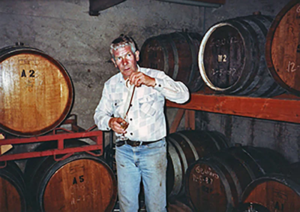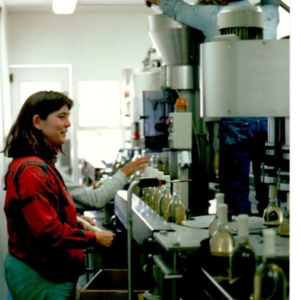Riesling Wine Roots: A History of Riesling Planting & Production in Anderson Valley
Once a Fast-Rising Favorite, Riesling Has Since Become a Sought-After Rarity in the Region
The reputation of Riesling is that of a sweet tooth’s wine, but its high acidity, floral aromatics and fruity flavor profile make it a versatile, fascinating addition to the white wine world. In Anderson Valley, Riesling played a major part in shaping the area’s early wine identity, but as more local winemakers began focusing on the likes of Pinot Noir and Chardonnay, Riesling became a cherished, yet diminished, part of the wine region’s legacy.
An influx of Italian immigrants made their way to Anderson Valley during the late 1890s and early 20th century due to ongoing economic and political unrest in their homeland, and they brought with them both wine-making techniques and a thirst and love for wine. Many of them homesteaded along Greenwood Ridge, which had a vastly different climate than other parts of Anderson Valley despite being so close by.
Situated about 1,600 feet above sea level, Greenwood Ridge didn’t experience the heavy fog or springtime frosts of lower-altitude Anderson Valley areas. The ridgetop also saw considerable sunlight and consistent temperatures thanks to its close proximity to the Pacific Ocean, and many Italian immigrants thought it reminiscent of their homelands in Northern Italy, where similar conditions led to the creation of thriving vineyards.
Among the first to plant Riesling grapes along the ridge known as “Vinegar Hill” in Boontling, the local dialect spoken in nearby Boonville, was Charles Hagemann, who did so around 1910. Yet, by 1914, Prohibition hit the area, resulting in the Ridge and Valley going “dry.”

Tony Husch & Al White
While Prohibition halted early winemaking efforts in Anderson Valley for a period, the 1960s and 1970s brought a renewed interest in Alsatian varietals like Riesling, Gewürztraminer, Pinot Gris & Pinot Blanc to the region. Tony Husch, of Husch Vineyards, planted Riesling grapes on Greenwood Ridge in 1972 alongside his vineyard consultant, Alfred White, before selling the property in 1973. Photo of Tony & Al featured left.
Brad Wiley also got in on the Riesling grape-growing game in the 1970s, planting his own rooted Riesling (meaning he planted vines on their own roots, rather than grafting them onto a different vine species) in 1976. This Riesling operation still exists today, with the likes of Read Holland Wines and Desire Lines Wines relying on these grapes to craft their blends.
The following year, the grapes initially planted along Greenwood Ridge by Tony Husch reached maturity and Allan Green’s family took possession of the Green Ranch vineyard. Allan’s winery, named Greenwood Ridge Vineyards, a small, family-owned winery in Philo, then released its first Riesling using the grapes in 1980, helping further establish the region as a hub for Riesling wine production.
Edemeads also tried his luck with making Riesling wines, including the 11.5% alcohol semi-dry Whale Riesling, where proceeds of the wine went to the Whale Protection Fund, and a 26.4% late harvest Riesling from the B.J. Carney Vineyard in Boonville (now owned by Roederer).
 Philo’s Navarro Vineyards also played a part in putting Anderson Valley Riesling on the map, planting its own Riesling grapes in 1991 using the Neustadt 90 clone. Before that Navarro started producing Riesling in 1978, sourcing grapes from Valley Foothills Vineyard, then owned by Bob Tamiso and Marvan Shanken, the latter of whom went on to buy “Wine Spectator” magazine in 1979.
Philo’s Navarro Vineyards also played a part in putting Anderson Valley Riesling on the map, planting its own Riesling grapes in 1991 using the Neustadt 90 clone. Before that Navarro started producing Riesling in 1978, sourcing grapes from Valley Foothills Vineyard, then owned by Bob Tamiso and Marvan Shanken, the latter of whom went on to buy “Wine Spectator” magazine in 1979.
 Han’s Kobler, founder of Lazy Creek Vineyards, also sourced Riesling grapes from Valley Foothills in the mid-1980s. His son Norman Kobler confirmed his parents never planted Riesling on their own property, but they did produce several Riesling and Late Riesling-style wines, helping further establish Mendocino County as a key region for Riesling production.
Han’s Kobler, founder of Lazy Creek Vineyards, also sourced Riesling grapes from Valley Foothills in the mid-1980s. His son Norman Kobler confirmed his parents never planted Riesling on their own property, but they did produce several Riesling and Late Riesling-style wines, helping further establish Mendocino County as a key region for Riesling production.
Several decades later, in 2011, Norman planted the Vonarburg Vineyard in tribute to his parents and their love for Alsatian varietals. His father, especially, had a long-standing love for Riesling and relied on pre-plant contracts to start the vineyard. To this day, only three wine producers – Arista, Cobb Wines and Reeve Wines– have secured rights to it.

Handley Cellars, also in Philo, further contributed to Anderson Valley’s Riesling legacy despite never planting its own Riesling grapes, producing its first Riesling, a late harvest variety, in 1990. Winemaker & founder, Milla Handley, sourced fruit from Dennison’s, a vineyard near “Octopus Mountain” which is on the west side of Boonville. She later sourced from Green Ranch and made Riesling through 2018 but ceased production on Riesling wines after being unable to find grapes grown in line with their strict production standards with organic farming. The good news is that they’ve sourced new fruit and Handley will soon release a 2024 Riesling; its first Riesling wine in six years.
The delicate nature of Riesling grapes makes them prone to sunburn and susceptible to rot, so Riesling wine producers have to strike a careful balance between protecting them from the elements and ensuring they get the exposure they need to grow and thrive.
Despite these challenges, several dedicated Anderson Valley wine producers continue to craft this aromatic and fruit-forward white wine variety, including Cobb Wines, Handley Cellars, Navarro Vineyards, Read Holland Wines, Reeve Wines and Toulouse Vineyards.
While Riesling may be a bit harder to find in Anderson Valley today than it was in years past, these passionate producers and top Riesling wineries are committed to keeping the tradition – and the region’s Riesling history – alive.
Stop by for a glass or a bottle of the sometimes-sweet, sometimes-dry variety during the upcoming International White Wine Festival (Feb. 15 – 16, 2025) and see why Riesling continues to cement itself a standout in Anderson Valley’s storied winemaking legacy. Cheers!